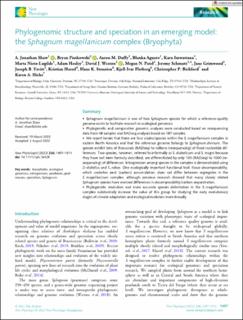| dc.contributor.author | Shaw, A. Jonathan | |
| dc.contributor.author | Piatkowski, Bryan | |
| dc.contributor.author | Duffy, Aaron M. | |
| dc.contributor.author | Aguero, Blanka | |
| dc.contributor.author | Imwattana, Karn | |
| dc.contributor.author | Nieto-Lugilde, Marta | |
| dc.contributor.author | Healey, Adam | |
| dc.contributor.author | Weston, David J. | |
| dc.contributor.author | Patel, Megan N. | |
| dc.contributor.author | Schmutz, Jeremy | |
| dc.contributor.author | Grimwood, Jane | |
| dc.contributor.author | Yavitt, Joseph B. | |
| dc.contributor.author | Hassel, Kristian | |
| dc.contributor.author | Stenøien, Hans K. | |
| dc.contributor.author | Flatberg, Kjell Ivar | |
| dc.contributor.author | Bickford, Christopher P. | |
| dc.contributor.author | Hicks, Karen A. | |
| dc.date.accessioned | 2023-11-22T07:14:04Z | |
| dc.date.available | 2023-11-22T07:14:04Z | |
| dc.date.created | 2022-11-09T09:36:23Z | |
| dc.date.issued | 2022 | |
| dc.identifier.citation | New Phytologist. 2022, 236 (4), 1497-1511. | en_US |
| dc.identifier.issn | 0028-646X | |
| dc.identifier.uri | https://hdl.handle.net/11250/3103969 | |
| dc.description.abstract | Sphagnum magellanicum is one of two Sphagnum species for which a reference-quality genome exists to facilitate research in ecological genomics.
Phylogenetic and comparative genomic analyses were conducted based on resequencing data from 48 samples and RADseq analyses based on 187 samples.
We report herein that there are four clades/species within the S. magellanicum complex in eastern North America and that the reference genome belongs to Sphagnum divinum. The species exhibit tens of thousands (RADseq) to millions (resequencing) of fixed nucleotide differences. Two species, however, referred to informally as S. diabolicum and S. magni because they have not been formally described, are differentiated by only 100 (RADseq) to 1000 (resequencing) of differences. Introgression among species in the complex is demonstrated using D-statistics and f4 ratios. One ecologically important functional trait, tissue decomposability, which underlies peat (carbon) accumulation, does not differ between segregates in the S. magellanicum complex, although previous research showed that many closely related Sphagnum species have evolved differences in decomposability/carbon sequestration.
Phylogenetic resolution and more accurate species delimitation in the S. magellanicum complex substantially increase the value of this group for studying the early evolutionary stages of climate adaptation and ecological evolution more broadly. | en_US |
| dc.language.iso | eng | en_US |
| dc.publisher | New Phytologist Foundation. | en_US |
| dc.title | Phylogenomic structure and speciation in an emerging model: the Sphagnum magellanicum complex (Bryophyta) | en_US |
| dc.title.alternative | Phylogenomic structure and speciation in an emerging model: the Sphagnum magellanicum complex (Bryophyta) | en_US |
| dc.type | Peer reviewed | en_US |
| dc.type | Journal article | en_US |
| dc.description.version | publishedVersion | en_US |
| dc.source.pagenumber | 1497-1511 | en_US |
| dc.source.volume | 236 | en_US |
| dc.source.journal | New Phytologist | en_US |
| dc.source.issue | 4 | en_US |
| dc.identifier.doi | 10.1111/nph.18429 | |
| dc.identifier.cristin | 2070978 | |
| cristin.ispublished | true | |
| cristin.fulltext | original | |
| cristin.qualitycode | 2 | |
